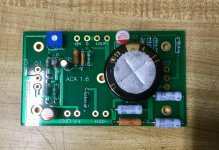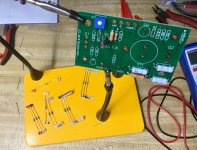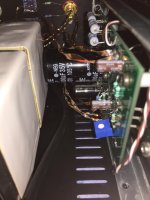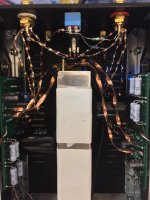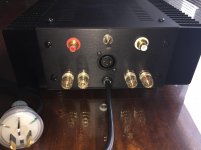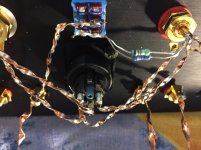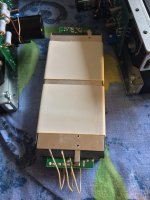I recently bought a balanced preamp to go with my ACA 1.6. I figured I’d buy another ACA and run them as balanced monoblocks.
After ordering the second amp, I ran across this thread and thought I’d update the second amp with the premium parts. One board finished yesterday and I should have the second board finished this weekend, if my home projects allow.
I’ll listen to the second amp and see if I can hear a difference for the better, comparing the first to the second. If I do, I’ll update the first amp with the premium part changes.
After ordering the second amp, I ran across this thread and thought I’d update the second amp with the premium parts. One board finished yesterday and I should have the second board finished this weekend, if my home projects allow.
I’ll listen to the second amp and see if I can hear a difference for the better, comparing the first to the second. If I do, I’ll update the first amp with the premium part changes.
Attachments
I recently bought a balanced preamp to go with my ACA 1.6. I figured I’d buy another ACA and run them as balanced monoblocks.
After ordering the second amp, I ran across this thread and thought I’d update the second amp with the premium parts. One board finished yesterday and I should have the second board finished this weekend, if my home projects allow.
I’ll listen to the second amp and see if I can hear a difference for the better, comparing the first to the second. If I do, I’ll update the first amp with the premium part changes.
Did you have the time for that comaparative listening ?
Did you have the time for that comaparative listening ?
I did. I found a noticeable difference between the two amps- one ACA 1.6 stock and on ACA 1.6 modified following TungstenAudio’s mods. (Post #31, I think).
The modded ACA was more interesting and lively. I could hear more details in the modded amp and easily pick out which channel it was driving. When I played each amp driving both channels, I preferred the modded one.
I bought the parts from Mouser. Maybe $50 total for both amps. The reworking of the first amp was a slight pain, but not too bad. Worth the time and money. I set the bias to 12.4v.
My current set up is high efficiency speakers, a balanced preamp and the ACA monoblocks balanced.
I finally got around to building a 2nd ACA with the modifications suggested by TungstenAudio and the improvement over the stock build is very positive. Next I will modify my original ACA and try the parallel mono configuration - I expect more improvements!
Can someone recommend a source for the 0.5 ohm resistors? For this build I used a parallel 2 ohm resistor because I couldn't find a single 0.5 ohm.
Thanks
Can someone recommend a source for the 0.5 ohm resistors? For this build I used a parallel 2 ohm resistor because I couldn't find a single 0.5 ohm.
Thanks
If you play around with the values of R1-R4 you will change the THD profile. It would be interesting to try a 0.5 Ohm pot. I experimented quite a bit including making a switched pot with .05 Ohm resistors. You should be able to find results in the ACA thread. I ended up putting it back to stock values.
THD with R3 - R4 changes
@Loudthud
Did you do a full analysis of the ACA with TungstenAudio’s premium parts mods? If so can you share them here?
I’m starting 3 ACA’s this weekend, I have all of the premium parts, but your comments on R1 – R4 changes affecting the THD profile, I’d like to be sure before I wired them up.
Thanks, Aguaazul
If you play around with the values of R1-R4 you will change the THD profile. It would be interesting to try a 0.5 Ohm pot. I experimented quite a bit including making a switched pot with .05 Ohm resistors. You should be able to find results in the ACA thread. I ended up putting it back to stock values.
@Loudthud
Did you do a full analysis of the ACA with TungstenAudio’s premium parts mods? If so can you share them here?
I’m starting 3 ACA’s this weekend, I have all of the premium parts, but your comments on R1 – R4 changes affecting the THD profile, I’d like to be sure before I wired them up.
Thanks, Aguaazul
@Loudthud Did you do a full analysis of the ACA with TungstenAudio’s premium parts mods? If so can you share them here?
The work of which you speak was done in 2012, so no. The chances of me having any of TungstenAudio's premium parts is very low.
In the ACA thread:
Post 230 shows different R1-R4 plots
Post 274 and 284 shows what I arrived at for lowest THD
Post 576 discusses THD vs P1 set Voltage
Post 614 and 620 comments about smaller Fets
To get the lowest THD I had to increase R1-4 and installed a resistor, now called R15, to restore idle current. I eventually went back to the stock values and now I listen with smaller FETs and the feedback disconnected. I like THD, makes music sound louder.
A German DIY-friend asked me to give him "the needed PCBs" for an ACA-amplifier - and I did, "according to my sound-impressions" 

https://abload.de/img/premium_integrated_acgpkbf.jpg
From left to right:
1) The ACA -PCB, based on TungstenAudios recommendations and including his mods
2) A CAPMx -PSU based on JasonKuetemanns CAP-Multiplier (the "best" CAPMx that I have ever listened to) : Simplified MrEvil / PMI Capacitance Multiplier
3) A LT4320 based rectifier, the author of which is PRASI
You are of course free to power this "Premium-parts ACA" from a SMPS-PSU, from another PSU or another bridge-rectifier, ...
I have ordered 10 PCBs of each (10 sets of the 3 PCBs shown above) yesterday, 8 of which I want to offer in this post.
If you like: I will assist you in:
1) having genuine (!) Toshiba 2SK170 transistors
2) having MPC74 - resistors
3) .. and having whatever component is "hard to find"
If you are interested in my PCBs:
I offer to you sets consisting of 3 PCBs (shown above).
A 3 -PCB- set costs 10€.
Shipping within the European tax-zone (I do prefer orders from within the European tax zone) is 3.70€.
2 PCB-sets will then cost 25€ (including PAYPAL-fee) within the European tax-zone.
Please enter your "interest EMOJI" - Rudi_Ratlos
P.S.: I am currently thinking about how to add a "low shipping cost" for DHL-orders outside the European tax_zone.

https://abload.de/img/premium_integrated_acgpkbf.jpg
From left to right:
1) The ACA -PCB, based on TungstenAudios recommendations and including his mods
2) A CAPMx -PSU based on JasonKuetemanns CAP-Multiplier (the "best" CAPMx that I have ever listened to) : Simplified MrEvil / PMI Capacitance Multiplier
3) A LT4320 based rectifier, the author of which is PRASI
You are of course free to power this "Premium-parts ACA" from a SMPS-PSU, from another PSU or another bridge-rectifier, ...
I have ordered 10 PCBs of each (10 sets of the 3 PCBs shown above) yesterday, 8 of which I want to offer in this post.
If you like: I will assist you in:
1) having genuine (!) Toshiba 2SK170 transistors
2) having MPC74 - resistors
3) .. and having whatever component is "hard to find"
If you are interested in my PCBs:
I offer to you sets consisting of 3 PCBs (shown above).
A 3 -PCB- set costs 10€.
Shipping within the European tax-zone (I do prefer orders from within the European tax zone) is 3.70€.
2 PCB-sets will then cost 25€ (including PAYPAL-fee) within the European tax-zone.
Please enter your "interest EMOJI" - Rudi_Ratlos
P.S.: I am currently thinking about how to add a "low shipping cost" for DHL-orders outside the European tax_zone.
Discoveries on Amp Camp with premium parts
I have been soldering for quite a spell, but my previous experience has been with single sided PCB's. I had been listening to my version 1.6 the other day for several hours and I noticed it started sounding distorted. It sounded fine when I first turned it on, what was going on? Perhaps my discovery is obvious to most of you, but as I said, my experience had been with single sided boards. I had made careful inspection of the bottom of the circuit boards, and they looked fine. Then it hit me, these boards are dual sided, and there are traces on the top too. Often when I made my connections on the bottom side, there would be solder that would flow through the hole and be deposited at the top solder pad, but not always. I discovered my distortion problem was with the input FET. There wasn't any solder on the top pads for the legs, and that is where the circuit trace connection really was for the component. The heat revealed the weak connections on the top of the board. I re-soldered the top connections for everything and now the amp sounds fine. If you have problems with your amp, make sure that your solder connections are good on both sides of the board. Perhaps I am late to the party with this observation?
Tungsten Audio has posted many good mods for making your amp more refined, and I think they are worth the effort, though I have not heard an Amp Camp in stock form. I am using the 24 volt Meanwell brick filtered through a 10mH Hammond choke, and have used a 1000uf Elna for C4 without problems. I used a 47uf Elna bi-polar 100 volt cap for C3, and a 4700 uf 63 volt Gold Nichicon for C1 with a .1uf and .01 uf bypass on C1, and a .01uf bypass on the 47uf input Elna.
If your LED is too bright, I have used a 49K resistor for R13 that tames the brightness nicely, though still plenty bright. I still have 10K for R11, but have installed a 150K resistor for R12 with a 10pf cap paralleled suggested by Tungsten. I have used a IRFP044 for Q1 which firms up the bass over the 240 stock Mosfet for my speakers, some open baffle home brews with a couple 12 inch full ranges, and the mid-range horn from a Heresy and it's tweeter. I have not noticed it being bloated sounding and the treble is fine. The reason I tried the 150K for R12 was from reading a post that said the IRFP044 sounded dark, and cutting the feedback I figured might tame any possible bloating on the low end without affecting the audible treble as much from looking at frequency response of the amp with and without feedback.
The Amp Camp sounds similar to my Tubelab SE, but has better bass than the Tubelab. I have a re-vamped to dual mono B&K ST-140, and it sounds veiled and closed in compared to the Amp Camp. The Amp Camp is a great little amp to consider if the low power output is sufficient for your speakers, and I thank Mr. Pass and others of the DIY community for their shared tips for this quality jewel of an amp
I have been soldering for quite a spell, but my previous experience has been with single sided PCB's. I had been listening to my version 1.6 the other day for several hours and I noticed it started sounding distorted. It sounded fine when I first turned it on, what was going on? Perhaps my discovery is obvious to most of you, but as I said, my experience had been with single sided boards. I had made careful inspection of the bottom of the circuit boards, and they looked fine. Then it hit me, these boards are dual sided, and there are traces on the top too. Often when I made my connections on the bottom side, there would be solder that would flow through the hole and be deposited at the top solder pad, but not always. I discovered my distortion problem was with the input FET. There wasn't any solder on the top pads for the legs, and that is where the circuit trace connection really was for the component. The heat revealed the weak connections on the top of the board. I re-soldered the top connections for everything and now the amp sounds fine. If you have problems with your amp, make sure that your solder connections are good on both sides of the board. Perhaps I am late to the party with this observation?
Tungsten Audio has posted many good mods for making your amp more refined, and I think they are worth the effort, though I have not heard an Amp Camp in stock form. I am using the 24 volt Meanwell brick filtered through a 10mH Hammond choke, and have used a 1000uf Elna for C4 without problems. I used a 47uf Elna bi-polar 100 volt cap for C3, and a 4700 uf 63 volt Gold Nichicon for C1 with a .1uf and .01 uf bypass on C1, and a .01uf bypass on the 47uf input Elna.
If your LED is too bright, I have used a 49K resistor for R13 that tames the brightness nicely, though still plenty bright. I still have 10K for R11, but have installed a 150K resistor for R12 with a 10pf cap paralleled suggested by Tungsten. I have used a IRFP044 for Q1 which firms up the bass over the 240 stock Mosfet for my speakers, some open baffle home brews with a couple 12 inch full ranges, and the mid-range horn from a Heresy and it's tweeter. I have not noticed it being bloated sounding and the treble is fine. The reason I tried the 150K for R12 was from reading a post that said the IRFP044 sounded dark, and cutting the feedback I figured might tame any possible bloating on the low end without affecting the audible treble as much from looking at frequency response of the amp with and without feedback.
The Amp Camp sounds similar to my Tubelab SE, but has better bass than the Tubelab. I have a re-vamped to dual mono B&K ST-140, and it sounds veiled and closed in compared to the Amp Camp. The Amp Camp is a great little amp to consider if the low power output is sufficient for your speakers, and I thank Mr. Pass and others of the DIY community for their shared tips for this quality jewel of an amp

Based on previous experience using single core speaker cable V's multicore I've bought some of enough of this for Two ACA and and a Nutube build I'll start when the bits arrive:
Amtrans OFC gold plated wire, 0.9mm dia, with PFA sleeving | Hifi Collective
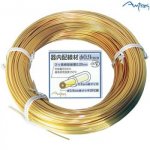
It's real perty!
Amtrans OFC gold plated wire, 0.9mm dia, with PFA sleeving | Hifi Collective

It's real perty!
does this improve total wattage on the output? with dc bias increase from 12.0v to 12.4v , is there any space to go even further?To all who have been following this thread, know that I'm grateful to be part of this community. I am especially humbled by the praise of the one and only N. Pass who has so generously given of his designs and his experience. <snip>
I made several rounds of modifications to my ACAs. The first pair used the kit 24V SMPS bricks and PCBs. The changes that I made increased both the gain and bias current by changing the values of some of the components. I also tried a couple different ways of bridging the pair of amplifiers to be used as monoblocks to drive my medium-efficiency (88 dB) Vandersteen 2C speakers. I was pretty happy with the results, and was able to fill my large (12.5 ft by 25.5 ft) living room somewhat better than the stock amps were capable of doing. With my system, the parallel bridged configuration proved to sound the best.
After that I built a few different versions of the ACA using a modified PCB design that included provisions for local power supply capacitance, an optional linear regulator, and an RC dropping filter at the drain of the input JFet. These versions eventually resulted in the ACA-220 v1 and v2, which were built in old Hafler DH-220 chassis. The steps I took are documented in this thread. Again, the goal was to build an amp that drove my speakers to a satisfactory volume, but using a single chassis with a dual-mono linear power supply.
Given the new linear power supplies, I increased the ACA rail voltages and experimented with CRCRC filter networks and different bridge rectifiers. The increased rail voltages required increased DC bias voltages and the larger heatsinks of the Hafler chassis in order to dissipate the extra power. The RC dropping filter was necessary to prevent excessive voltage from appearing at the drain of the input JFet.
I was very pleased with these builds as well. In particular, the ACA-220 v2, which ran with over 28 Volts on its power rails and 1.6 Amps of quiescent current through its IRFP140 output Fets, sounded wonderful and did a better job of filling my living room with sound than the earlier monoblocks. I haven't made any measurements on these amplifiers, but will probably do so to satisfy my curiosity. I expect the ACA-220 builds will achieve greater wattage at 1% distortion than the monoblocks running on the 24V bricks.
The ACA-220 circuit and configuration definitely has space to go even further. The stock ACA boards are limited by their lack of the RC dropping network in the front end, and are probably best left at around 24 Volt rails. One could certainly try building an amp with a pair of these boards and a linear supply based on a 200VA or 300VA transformer with 20V secondary windings. I would recommend the IRFP140 transistors for the output stage.
I already have some parts and chassis to try higher power versions of the ACA, but have had those on hold for several months as I have been enjoying my M2x and Aleph J. Yes, the bigger amps give bigger and better results in their stock configuration, but that hasn't stopped my from tweaking those as well.
After that I built a few different versions of the ACA using a modified PCB design that included provisions for local power supply capacitance, an optional linear regulator, and an RC dropping filter at the drain of the input JFet. These versions eventually resulted in the ACA-220 v1 and v2, which were built in old Hafler DH-220 chassis. The steps I took are documented in this thread. Again, the goal was to build an amp that drove my speakers to a satisfactory volume, but using a single chassis with a dual-mono linear power supply.
Given the new linear power supplies, I increased the ACA rail voltages and experimented with CRCRC filter networks and different bridge rectifiers. The increased rail voltages required increased DC bias voltages and the larger heatsinks of the Hafler chassis in order to dissipate the extra power. The RC dropping filter was necessary to prevent excessive voltage from appearing at the drain of the input JFet.
I was very pleased with these builds as well. In particular, the ACA-220 v2, which ran with over 28 Volts on its power rails and 1.6 Amps of quiescent current through its IRFP140 output Fets, sounded wonderful and did a better job of filling my living room with sound than the earlier monoblocks. I haven't made any measurements on these amplifiers, but will probably do so to satisfy my curiosity. I expect the ACA-220 builds will achieve greater wattage at 1% distortion than the monoblocks running on the 24V bricks.
The ACA-220 circuit and configuration definitely has space to go even further. The stock ACA boards are limited by their lack of the RC dropping network in the front end, and are probably best left at around 24 Volt rails. One could certainly try building an amp with a pair of these boards and a linear supply based on a 200VA or 300VA transformer with 20V secondary windings. I would recommend the IRFP140 transistors for the output stage.
I already have some parts and chassis to try higher power versions of the ACA, but have had those on hold for several months as I have been enjoying my M2x and Aleph J. Yes, the bigger amps give bigger and better results in their stock configuration, but that hasn't stopped my from tweaking those as well.
Here is the PSU upgrade of my ACA : 300VA audio grade transformer + 6A/24V ultra low noise power supply.
That's pretty sexey looking, so I had to track it down on ebay - Wow thats A $260 dolar power supply without the Toroidy. How does that compare to the build price of the DIYAudio universal power supply once it's populated with parts?
That's pretty sexey looking, so I had to track it down on ebay - Wow thats A $260 dolar power supply without the Toroidy. How does that compare to the build price of the DIYAudio universal power supply once it's populated with parts?
So 300VA means it could power two ACA?
- Home
- Amplifiers
- Pass Labs
- ACA amp with premium parts
